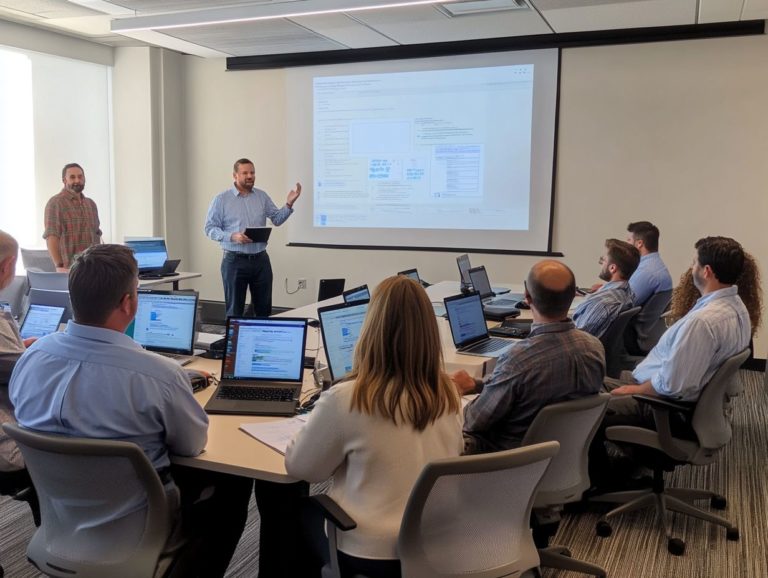the importance of phishing tests in training
Phishing attacks represent a substantial threat in today’s digital landscape, casting a wide net that ensnares both individuals and organizations.
Grasping the nuances of phishing and the various forms it can take is essential for protecting your sensitive information. This article delves into the critical need for phishing tests and underscores the importance of training to bolster your defenses.
Discover how to design effective tests, evaluate their success, and adopt best practices for phishing training within your organization. Equip yourself with the knowledge necessary to thwart these deceptive attacks and safeguard your digital environment.
Contents
- Key Takeaways:
- Understanding Phishing Attacks
- The Need for Phishing Tests
- Creating Effective Phishing Tests
- Measuring the Success of Phishing Tests
- Implementing Phishing Training in Organizations
- Frequently Asked Questions
- Why are phishing tests important in training?
- How often should phishing tests be conducted?
- What types of phishing tests are available?
- What are the benefits of conducting phishing tests?
- How can organizations ensure the effectiveness of phishing tests?
- What should employees do if they fall for a phishing test?
- What to Do If You Fall for a Phishing Test
- Types of Phishing Tests
- Benefits of Phishing Tests
- Ensuring Effective Phishing Tests
Key Takeaways:

Regular phishing tests play a crucial role in training employees to spot and handle phishing attacks. This protects sensitive information and helps prevent financial losses. Training employees on phishing attacks is essential as it helps them understand the different types of attacks and how to identify and avoid them in the future. To ensure the effectiveness of phishing tests, organizations should use key elements and features such as realistic scenarios and personalized feedback, and regularly evaluate the success of these tests through metrics and best practices.
Understanding Phishing Attacks
Phishing attacks are an escalating concern in the world of cybersecurity. They trick individuals into disclosing sensitive information via deceptive emails or fraudulent websites.
As phishing techniques become ever more sophisticated, grasping the essence of phishing is crucial for crafting effective prevention strategies. Organizations must take proactive steps in educating employees about phishing threats and fostering a strong culture of cybersecurity awareness to protect against potential scams.
What is Phishing?
Phishing is a fraudulent practice where deceptive emails are sent with the intent of tricking you into revealing sensitive information, such as passwords, credit card numbers, or personal identification details.
These messages often masquerade as legitimate communications from trusted sources, like banks or well-known companies, designed to create a sense of trust and urgency.
Phishing emails often use psychological tactics like fear and excitement to manipulate your emotions and prompt immediate action. Subjects that threaten account suspension or present exclusive deals compel you to click on malicious links or fill out harmful forms.
This is why it’s crucial for you to be equipped with proper phishing education! Understanding these schemes helps you develop awareness, protecting your sensitive information from falling into the hands of cybercriminals.
Enhanced education gives you the power to recognize warning signs and approach suspicious communications with the caution they deserve.
Types of Phishing Attacks
You should be aware that there are several types of phishing attacks, each designed to exploit trust and compromise your sensitive information. These include targeted phishing aimed at specific people, whaling, and voice phishing, where attackers use phone calls instead of emails.
Targeted phishing often leverages personalized information to craft messages that are difficult to resist. Whaling, on the other hand, zeroes in on high-profile targets like executives, using meticulously crafted emails that exude an air of legitimacy.
Voice phishing adds a voice element into the mix, using phone calls that masquerade as trusted sources to extract sensitive data. Ransomware attacks frequently stem from phishing attempts, where malicious links or attachments can encrypt your files and then demand a ransom for their release.
This interconnectedness highlights the importance of remaining vigilant in identifying and mitigating these threats across various platforms.
The Need for Phishing Tests
Phishing tests are essential for elevating your organization’s cybersecurity strategy. They offer valuable insights into how employees react to phishing attempts, thereby cultivating a culture of security awareness throughout the workplace.
By regularly conducting phishing simulation training, you not only enhance employees’ understanding of phishing threats but also empower them with the skills necessary to recognize and respond to phishing emails effectively.
This proactive approach significantly strengthens your overall security posture.
Start implementing phishing tests today and empower your team to recognize threats with confidence!
Why Training is Important
Phishing training is crucial for empowering you and your colleagues with the knowledge and skills needed to effectively recognize and respond to phishing threats. This significantly reduces the risk of a successful attack.
Such training teaches you about the common tactics employed by cybercriminals and creates a watchful environment within your organization.
Understanding phishing schemes helps you identify suspicious emails or links. This leads to quicker reporting and response times.
As more team members sharpen their skills in spotting potential threats, the chances of a successful breach diminish, ultimately safeguarding sensitive data and preserving the integrity of operational processes.
Benefits of Regular Phishing Tests

Regular phishing tests offer actionable insights into the effectiveness of your phishing training programs. They help pinpoint weaknesses in employee responses and highlight areas that need extra attention for compliance.
These tests show how well your employees can recognize and respond to potential threats, boosting their awareness and vigilance.
The results from these simulations can inform the development of targeted training sessions, ensuring that the content is relevant and tailored to specific vulnerabilities.
As your teams engage in ongoing evaluations of their readiness, they become better equipped to face real cyber threats, ultimately enhancing your organization s overall security posture and compliance with industry regulations.
Creating Effective Phishing Tests
Creating effective phishing tests requires a deep understanding of phishing techniques. It s essential to design simulation exercises that closely replicate real-world phishing scenarios.
By doing so, you enable your organization to assess employees’ awareness and evaluate their response strategies effectively.
Key Elements and Features
Key elements of effective phishing tests include:
- Realistic simulation exercises
- A diverse array of phishing tools
- A robust framework for identifying phishing threats
This ensures that the tests truly measure employee preparedness.
By incorporating advanced phishing tools, you can replicate the sophisticated attack vectors that cybercriminals frequently use. This approach provides a more accurate assessment of your vulnerabilities.
Varying the types of phishing simulations be it emails, phone calls, or even social engineering tactics ensures that your employees face a wide range of scenarios. This variety keeps participants engaged and helps them understand threats better.
Collectively, these elements empower your organization to identify and mitigate phishing risks proactively.
Measuring the Success of Phishing Tests
To measure the success of phishing tests, adopt a comprehensive approach. This involves analyzing phishing detection methods and evaluating the overall effectiveness of your employees’ phishing training using relevant metrics.
Metrics for Evaluating Effectiveness
Key metrics for evaluating the effectiveness of phishing tests include:
- The percentage of employees falling for simulated phishing attempts
- The speed at which they report phishing emails
- The overall improvements in their phishing detection skills
Tracking the reduction in click rates on malicious links over time can reveal how awareness is evolving among your teams. Analyzing the time taken to identify and report potential threats will indicate how well your training programs resonate with staff.
By keeping an eye on these metrics, you can refine your training strategies, providing targeted sessions that address specific weaknesses.
This data-driven approach ensures that your ongoing training remains not only relevant but also effective, ultimately strengthening your overall security posture and reducing the risk of phishing attacks.
Don t wait! Start your training today to protect your organization.
Implementing Phishing Training in Organizations
Implementing phishing training within your organization requires a well-structured approach. This involves comprehensive phishing awareness initiatives and customized training programs for employees.
Ongoing reinforcement of strategies designed to prevent phishing attacks is also essential. By prioritizing these elements, you can foster a culture of vigilance and preparedness against phishing threats.
Best Practices and Tips

To ensure your phishing training is top-notch, focus on best practices such as:
- Regularly updating your training content.
- Engaging employees with interactive methods.
- Consistently assessing their responses to phishing simulations.
By cultivating an environment where employees feel inspired to participate actively, you can significantly bolster your organization s defenses against cyber threats.
Fun techniques like quizzes or contests can transform the learning process about phishing into something enjoyable and memorable.
Periodic assessments measure knowledge retention. They also pinpoint areas needing more attention, allowing for tailored follow-up sessions.
By emphasizing a proactive cybersecurity culture, you reinforce the shared responsibility among team members. This encourages them to remain vigilant and informed about emerging threats, creating a robust line of defense.
Frequently Asked Questions
Why are phishing tests important in training?
Phishing tests are important in training because they simulate real-life scenarios. They help employees recognize and avoid potential cyber threats and highlight the importance of simulated phishing attacks, providing opportunities for them to practice safe online behaviors.
How often should phishing tests be conducted?
The frequency of phishing tests may vary depending on the organization’s needs. However, it is recommended to conduct them at least once a quarter. Some organizations may choose to conduct them more frequently, such as once a month, to ensure continuous training and reinforcement.
What types of phishing tests are available?
There are several types of phishing tests, including simulated phishing emails, phone calls, or even physical USB drives left in common areas. Some organizations also use gamified phishing tests or simulated social engineering attacks.
What are the benefits of conducting phishing tests?
Conducting phishing tests can help increase employee awareness about cyber threats. It also improves their ability to identify and report suspicious activities.
Moreover, it allows organizations to identify vulnerable areas and develop targeted training to address them.
How can organizations ensure the effectiveness of phishing tests?
To ensure the effectiveness of phishing tests, organizations should make sure that the tests are realistic and relevant to their employees’ roles and responsibilities. It is also essential to provide immediate feedback and follow-up training to reinforce good behaviors.
What should employees do if they fall for a phishing test?
Employees should report the incident immediately and seek guidance on how to address any potential risks. This helps the organization improve its training and response strategies.
Start implementing these strategies today to secure your organization from phishing threats!
What to Do If You Fall for a Phishing Test
If you fall for a phishing test, report it immediately to your IT or security team.
Follow any steps they recommend, like changing your passwords or checking for harmful software.
Types of Phishing Tests
There are various phishing tests, including fake emails, phone calls, and even USB drives left in common areas.
Some organizations use fun, gamified tests or simulated social engineering attacks.
Benefits of Phishing Tests
Phishing tests boost employee awareness of cyber threats.
They also help organizations identify weak spots and create targeted training.
Ensuring Effective Phishing Tests
Make sure tests are realistic and relevant to your team s roles.
Provide immediate feedback and follow-up training to encourage safe practices.







